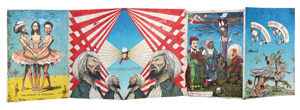 |
"Double Trouble 2", part of which is shown at top. b. sakata garo
|
| |
|
Enrique Chagoya is a visual cannibal. He eats up images from pre-Columbian cultures, Western religious iconography and American popular culture, and then spits them back out in irreverent works that satirize politics, society and the art world. Reflecting the psychological displacement immigrants experience in images that are often violent and disturbing, his paintings, drawings and prints are a blend of humor and pointed social criticism.
Born in Mexico City in 1953, Chagoya came to the United States in 1977. Though his father taught him to paint when he was a child, he studied political economy at Universidad Nacional Autonoma de Mexico. After coming to the United States, his interest shifted back to art and he earned a bachelor's degree from San Francisco Art Institute and a master's degree from the University of California, Berkeley, in the 1980s.
A professor of art at Stanford University, Chagoya has won many awards and has had solo shows at the Alternative Museum in New York, M.H. de Young Museum in San Francisco, the Nevada Museum of Art in Reno and the C.N. Gorman Museum at UC Davis. His current exhibition at b. sakata garo is his first in a Sacramento gallery and offers a survey of works from the 1990s to the present.
The pieces on view range from large charcoal and pastel works on paper to accordion-pleated prints that unfold like pre-Columbian codices to reveal a picaresque series of cartoonlike panels that critique contemporary art and culture. From the disturbing charcoal and pastel drawing "Barbarie/Civilization" to the irreverent multi-media print "Double Trouble or Anthropology of the Clone," the show explores Chagoya's cultural tourism as he takes us on a trip through past and present cultural icons.
In "Barbarie/Civilization," Donald Duck leaves black footprints on a table red with blood from the cut-off heads of figures whose necks sprout red snakes. "Double Trouble ..." juxtaposes Aunt Jemima, Lucille Ball, John Wayne, Arnold Schwarzenegger and Osama Bin Laden in a hilarious examination of the hegemony of U.S. culture. Combining woodcut and lithography on handmade paper, the print, like Mayan codices, is read from right to left.
"The Misadventures of the Romantic Cannibals," another codex that combines comic-book characters, ethnic stereotypes, Christian iconography, Mayan figures, Mexican pornography and appropriated engravings, is even more politically incorrect and confrontational. In it, George Washington and Abraham Lincoln, Christ and the Virgin Mary, piglike women and aliens from outer space populate a fictive landscape in which airplanes hover and stretch convertibles speed by on writhing roads.
In other works, Chagoya appropriates sententious 19th century prints and works them over with satirical and often jarring images. In "The Marriage of St. Catharine," the Christ child in a Van Dyck engraving wears the mask of a green monster. In "Rousseau and the Young Ladies," he places a cartoon of a married couple (woman wielding a rolling pin, man pulling her hair) under an idyllic engraving of a charming man dangling cherries over the heads of a pair of winsome women.
In his larger works, Chagoya limits his palette to red, black and white, giving us perplexing, thinly limned images such as "Liberty," in which dinosaurs inhabit a cozy living room, and "Untitled (Shoes)," in which a pair of giant feet in men's dress shoes step on the points of ghostly pyramids. In the painterly acrylic "Untitled (Buddha, Christ, M.L.K.)," he submerges images of religious figures in thick passages of expressionistic paint.
Some of the works included strike one as afterthoughts. Three drawings titled "Poor George-After PG" are tepid knockoffs of Philip Guston's "Poor Richard" drawings of Nixon done during the Vietnam era. Chagoya's images of a Nixon-like President Bush lack the bite of Guston's wit and the vigor of his handwriting. And a series of Andy Warhol-like cans labeled, among other things, "Curator's Liver" and "Critics Tongue," are amusing but fail to cut close to the bone.
Enrique Chagoya Survey
WHERE: b. sakata garo, 923 20th St.
WHEN: Noon to 6 p.m. Tuesdays-Saturdays, through Saturday
INFORMATION: (916) 447-4276
